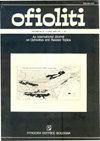SUBDUCTED BASALTS AND SEDIMENTS AS SOURCES FOR FELSIC DYKES IN THE MAWAT OPHIOLITE, NE IRAQ
IF 1.3
4区 地球科学
Q2 GEOLOGY
引用次数: 0
Abstract
The Mawat ophiolite is a fragment from the Neo-Tethyan oceanic lithosphere and is considered as the largest and best-exposed ophiolite within the Zagros Suture Zone, northeast Iraq. Felsic dykes are encountered in three locations in the Mawat ophiolite. Here, we use field work, petrology and geochemical data to investigate the magma sources of the felsic dykes. The felsic dykes are classified into two types: oceanic plagiogranites in the western (Mirza and Ismail, 2007) and leucogranites in the central (Mohammad et al., 2014) Mawat ophiolite, here called tonalites and granites, respectively. Both types, mixed in various proportions occur in the eastern felsic dykes. The eastern tonalites are weakly peraluminous to metaluminous and are low in K2O (0.13-0.24 wt%) and TiO2 (0.01-0.07 wt%) and high in Na2O (6.63-11.02 wt%). The eastern granites are strongly peraluminous, moderate to high in K2O (1.16-6.57 wt%) and Na2O (2.83-6.47 wt%), and very low in TiO2 (0.03-0.07 wt%). The western tonalites are similar to adakites and are interpreted to have crystallized from melts of subducted oceanic crust interacting with the mantle. The eastern tonalites underwent hornblende and plagioclase fractionation in shallow-level magma chambers modifying their original compositions. The granites are interpreted to derive from melting of psammitic sediments on top of the subducted slab. Parental melts of the tonalites and granites were partially mixed in shallow magma chambers in eastern Mawat.伊拉克东部MAWAT蛇绿岩中作为长英质岩脉来源的俯冲玄武岩和沉积物
Mawat蛇绿岩是新特提斯洋岩石圈的碎片,被认为是伊拉克东北部扎格罗斯缝合带内最大、暴露最好的蛇绿岩。在Mawat蛇绿岩的三个位置发现了长英质岩脉。在这里,我们利用野外工作、岩石学和地球化学数据来研究长英质岩脉的岩浆来源。长英质岩脉分为两种类型:西部的大洋斜长花岗岩(Mirza和Ismail,2007)和中部的浅色花岗岩(Mohammad et al.,2014)Mawat蛇绿岩,这里分别称为英云闪长岩和花岗岩。这两种类型以不同比例混合出现在东部长英质岩脉中。东部英云闪长岩为弱过发光至金属发光,K2O(0.13-0.24 wt%)和TiO2(0.01-0.07 wt%)含量低,Na2O含量高(6.63-11.02 wt%)。东部花岗岩为强过铝质,K2O(1.16-6.57 wt%)和Na2O(2.83-6.47 wt%)含量中等至较高,TiO2含量极低(0.03-0.07 wt%)。西部英云闪长岩类似于埃达克岩,被解释为是由与地幔相互作用的俯冲洋壳熔体结晶而成。东部英云闪长岩在浅层岩浆室内经历了角闪石和斜长石的分馏,改变了它们的原始成分。花岗岩被解释为来自俯冲板顶部的砂屑沉积物的熔融。英云闪长岩和花岗岩的母熔体在Mawat东部的浅层岩浆室内部分混合。
本文章由计算机程序翻译,如有差异,请以英文原文为准。
求助全文
约1分钟内获得全文
求助全文
来源期刊

Ofioliti
地学-地质学
CiteScore
2.40
自引率
7.70%
发文量
1
期刊介绍:
Since 1976, Ofioliti provides an international forum for original contributions and reviews in the field of the geodynamics, petrology, geochemistry, biostratigraphy, stratigraphy, tectonics and paleogeography applied to ophiolitic terrains and modern oceanic lithosphere, including their sedimentary cover. Studies of topics such as geodynamics of the mantle, the evolution of orogens including ophiolites and paleoceanography are also welcome
 求助内容:
求助内容: 应助结果提醒方式:
应助结果提醒方式:


